11-M: A DAY OF REMEMBRANCE/ 11-M: UN DIA DE MEMORIA
Travel Security
Originally posted on History Hiker on March 11, 2014
By Samuel Garza & Jim Sutton
This post is dedicated to the victims of the Madrid train bombing and also Francisco Javier Torrenteras of Spain’s Special Group, who gave his life in defense of his country.
Ten years ago, several bombs were detonated on four commuter trains in Madrid, Spain. The bombing sent shock waves around the world. One hundred and ninety one people were killed and 1,800 were injured*. March 11, 2004 locally known as “11-M” is a sad day in Spanish history.
This past week, I visited the Atocha train station where one of the 11-M memorials is located. Once I arrived, I was greeted at the door and received a very warm welcome. I walked in and I was immediately confronted by the 191 names of the the people who died on March 11, 2004.
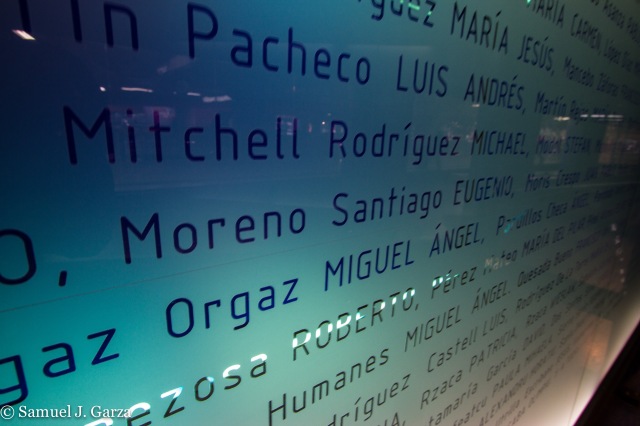
Names of the victims.
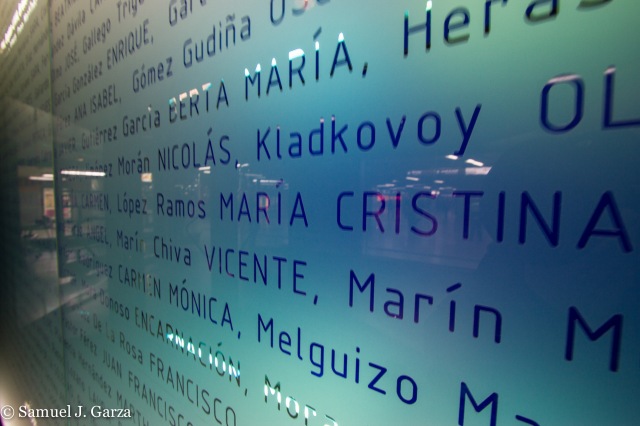
I was frozen. I couldn’t help but begin to read the names that were in front of me. In fact, I found myself reading the names out loudly. I finally stopped and walked through the second door into the remembrance chamber.
I found a seat and watched people stand under the light. I wanted to join them but instead, I found a seat and focused my eyes on the light. I thought about where I was when I heard of the attacks and what significance it had to me as an American.

Words of remembrance.
I made my way into the chamber to read the words of remembrance by many Spaniards discussing 11-M. Then I slowly made my way back to the exit and I made one last stop and looked at the names and said a prayer for the victims and their families.
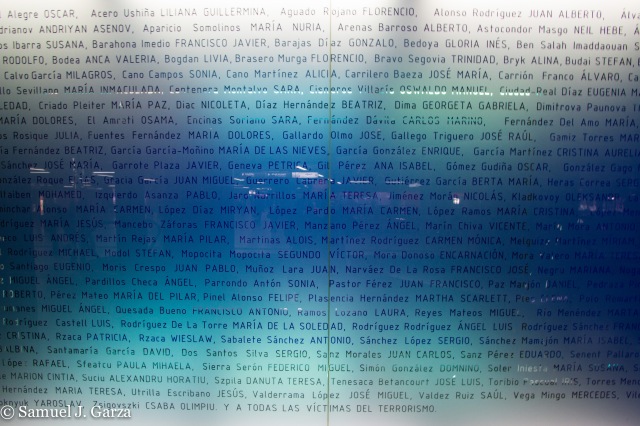
After leaving Atocha, I walked a few blocks to the Parque de el Retiro where another moment, the Bosque del Recuerdo was built to honor those killed in the Madrid attacks by planting 192 trees (191 for the 11-M victims and one for Torrenteras).
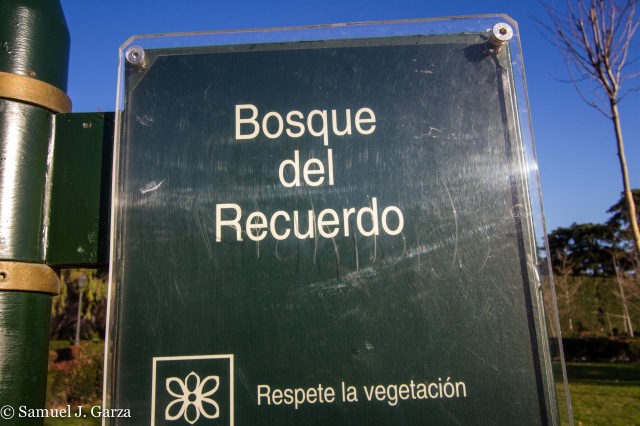

The Desecration of Torrenteras’ Grave
Shortly after the attacks on the Spanish rail system, Spanish authorities tracked down several key suspects to Leganes, a suburb of Madrid. Once the Special Forces approached the apartment where the suspects were hiding a powerful bomb exploded. The suspects had committed suicide and sadly, the bomb also killed Francisco Javier Torrenteras Gadea.
Over a month after Torrenteras was buried, his body was removed from his tomb and was destroyed by a pick and shovel. In addition, both his body and coffin were set on fire. This incident was not well reported internationally.
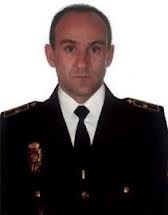
Francisco Javier Torrenteras
Interview With Mr. James Sutton
For more about 11-M attacks and its impact on transportation security, I interviewed Mr. James Sutton. Mr. Sutton is a former colleague, mentor, and friend. Currently Mr. Sutton is the Latin American and Caribbean Regional Director for Global Sigma.
Q&A
Samuel Garza: How did you hear about the attack?
James Sutton: At the time, March 11, 2004, I was conducting a threat risk and vulnerability assessment at Walter Reed Medical Center, a military hospital in Washington D.C. News of the bombing in Madrid interested me because I have family living in Spain, I have visited Madrid numerous times in the past and love the city. Finally an attack against a public transportation system — in one of Europe’s most beautiful cities, is noteworthy.
Samuel Garza: How has the bombing changed Spain?
James Sutton: The same way the September 11, 2001 attacks in New York and Washington changed the United States. While physical evidence of the attacks is beyond question, many conspiracy theories have developed during the years. These theories make claims that while may sound credible to many people are simply not supported by the evidence.
The death of 191 people and wounding 1,800 left a profound wound on the psyche of the Spanish people; just as September 11 changed the American psyche.
In both countries, there is an increased sense of vulnerability, a suspicion that the government has failed to disclose all the facts and evidence.
This sense of vulnerability is aggravated by all the security protocols that have been imposed at public buildings, aerial, naval, rail, and ground transportations systems. During every visit we are reminded that we are still vulnerable. Periodic assaults against transportations systems, hotels, and public buildings remind us of the continuing danger of another attack as well as the continuing struggle between the radical Muslims (Jihadi’s) and their perceived enemies. We need to remember the goal of terrorism is to terrorize civilian populations, we have acknowledge that the actions of few insane people willing to die and kill in the name of their God continues to preoccupy Spain, England, and the United States.
Samuel Garza: What was learned from the attack and how have those lessons changed transportation security?
James Sutton: It is impossible to protect 100% of any potential target, 100% of the time. We have to live with the knowledge that the best defense is an actively aware public that reports to the authority’s suspicious people and activities and security officers effectively trained and well informed on how best to handle, respond, and neutralize potential threats according to the rule of law. We cannot guarantee there will be no future assaults; there will be, but we can learn from past experience and mitigate or minimize the damage from upcoming attacks.
We need to keep in mind that modern technology such a video surveillance, metal detectors, and other modern technology has improved security.
The most important lesson we learned from recent terrorist attacks around the world is the importance of vigilance, effective response to suspicious incidents, public support of law enforcement (police/Guardia Civil) and for governments to provide long term economic and psychological support to the victims of these incidents. A major issue with the victims of 11-M is that to date many have not received adequate support to meet their needs. The economic challenges currently faced by Spain aggravate the problem, but there is room for improvements. As is the case with the victims of the New York and Washington attacks of September 11, 2001 many of which still face emotional and economic challenges all by themselves.
Samuel Garza: Do you feel that ETA had any evolvement in 11-M?
James Sutton: Everything is possible; however, the evidence to date indicates that although the explosives used were obtained in the Basque region of Spain they were not provided by ETA. The modus operandi of 11-M is not one typically used by ETA. While ETA is known to have operational linkages with insurgent radical groups in Colombia and Ireland, ETA’s struggle is political and social, while the 11-M bombers were involved in a religious/political struggle. I think the confusion arises from the fact that the explosive used by the assailants was Goma-2 ECO, often used in ETA attacks; also that the attackers — in fact — obtained the explosives from miners in Bilbao.
Samuel Garza: Has cooperation involving terrorism between Spain and the United States improved since 11-M?
James Sutton: The level of cooperation and collaboration, at the tactical, strategic, and political level is now significant and a partnership to deal with common enemy’s terrorists and drug-traffickers is excellent.
I had the pleasure of serving with the Spanish armed forces in the Western Region of Afghanistan, Badghis province. Also during my service a Special Agent of the FBI and Intelligence Analyst for the U.S. Department of Justice I had a chance to collaborate with the Spanish intelligence services and was impressed by their commitment, loyalty, and professionalism. I am sure that further improvements and collaborative efforts will be made in the future.
Samuel Garza: Where are there still vulnerabilities in the global transportation system and how can we prevent more attacks of this magnitude?
James Sutton: Any location in which a substantial number of people gather for a needed service, theaters, embassies, airports, buses and rail stations is vulnerable to an attack. Unfortunately this is the new normal and the threat cannot be completely eliminated. However, the average person can protect his or her own security by following three simple steps: (1) Stay alert, this includes being well informed of current events, (2) Have an action plan, what can you do in the event of a major incident, how can you limit harm to yourself and loved ones. (3) Trust your intuition; fear is subjective and psychological, while intuition is represents the knowledge of many generations which we often refer to as common sense.
Spanish/Español
Samuel Garza: ¿Cómo se enteró del ataque?
James Sutton: El 11 de marzo de 2004, estaba llevando a cabo una evaluación de riesgos de amenazas y vulnerabilidades en Walter Reed Medical Center, un hospital militar en Washington DC. Noticias del atentado en Madrid me interesó porque tengo familia que vive en España, he visitado Madrid numerosas veces en el pasado es una ciudad que me encanta. Por último un ataque contra el sistema de transporte público – en una de las ciudades más importantes y bellas de Europa es un incidente que merece considerable interés para un analista de inteligencia como yo lo era.
Samuel Garza: ¿Cómo ha cambiado el bombardeo España?
James Sutton: De la misma manera los ataques del 11 de septiembre de 2001 en Nueva York y Washington cambiaron los Estados Unidos. Mientras que la evidencia física de los ataques está fuera de toda duda, muchas teorías de conspiración han desarrollado durante los últimos años. Estas teorías hacen afirmaciones que, si bien puede sonar creíble para muchas personas simplemente no están respaldadas por las pruebas.
La muerte de 191 personas e hiriendo a 1800 dejaron una profunda herida en la psique del pueblo español, del mismo modo 11 de septiembre cambió la psique Latina.
En ambos países, hay una mayor sensación de vulnerabilidad, la sospecha de que el gobierno no ha revelado todos los hechos y las pruebas.
Esta sensación de vulnerabilidad se agrava por todos los protocolos de seguridad que se han impuesto en los edificios públicos, estaciones de tren, aeropuertos, embarques marítimos, y los sistemas de Autotransporte de tierra.
Durante cada visita se nos recuerda que aún somos vulnerables. Ataques repetidos contra los sistemas de transportes, hoteles y edificios públicos alrededor del mundo, nos recuerdan del constante peligro de otro ataque, así como la continua lucha entre los musulmanes radicales (yihadistas) y sus supuestos enemigos. Tenemos que recordar el objetivo del terrorismo es aterrorizar a la población civil, hemos de reconocer que las acciones de unos pocos locos dispuestos a morir y matar en nombre de su Dios continúa preocupando a España, Inglaterra y los Estados Unidos.
Samuel Garza: ¿Qué lecciones de seguridad aprendimos como resultado del asalto y que impacto tienen ese entendimiento para mejorar seguridad en el transporte público?
James Sutton: Es imposible proteger un recurso completamente 100 % del tiempo. Por eso tenemos que vivir con el conocimiento de que la mejor defensa es un público activamente consciente que informa a autoridad sobre condiciones, actividades, e individuos que son anormales o sospechosos.
Por su lado, las autoridades, tienen que estar efectivamente capacitados y bien informados sobre la mejor manera de manejar, responder y neutralizar amenazas potenciales de acuerdo con la ley vigente.
No podemos garantizar que no habrá asaltos futuros, inevitablemente los habrá. No obstante podemos aprender de la experiencia pasada y mitigar o minimizar los daños de incidentes futuros.
La lección más importante que hemos aprendido de los recientes ataques terroristas en todo el mundo es la importancia de la vigilancia, la respuesta eficaz a los incidentes sospechosos, el apoyo público de las fuerzas del orden (policía / Guardia Civil). Pero también la importancia que las autoridades proporcionen apoyo económico y psicológico — a largo plazo — para las víctimas de estos incidentes.
Recordemos también que los nuevos sistemas de video vigilancia, sensores de metal y otras tecnologías modernas han mejorado nuestra seguridad común.
Notablemente hasta la fecha actual muchas de las víctimas del 11 -M no han recibido suficiente apoyo para satisfacer sus necesidades. Los desafíos económicos que España enfrenta actualmente agravan ese problema, pero si existen posibilidades para mejorar ese problema.
Los mismo ha pasado con las víctimas de los atentados de Nueva York y Washington del 11 de septiembre 2001, muchos de los cuales todavía se enfrentan a desafíos emocionales y económicos por su propia cuenta.
Samuel Garza: ¿Cree que ETA estaba involucrada en el asalto de 11-M?
James Sutton: Todo es posible, sin embargo, la evidencia hasta la fecha indica que a pesar de que los explosivos utilizados se obtuvieron en la región vasca de España, esos mismos no fueron proporcionados por ETA. El modus operandi del 11-M no es uno utilizado habitualmente por ETA. Mientras se reconoce que ETA tiene vínculos operativos con grupos radicales e insurgentes en Colombia e Irlanda, la lucha de ETA es política y social, mientras que los atacantes del 11-M estaban involucrados en una lucha religiosa y política. Creo que la confusión surge del hecho de que el explosivo utilizado por los asaltantes era Goma-2 ECO, de uso frecuente en los atentados de ETA, y también que los atacantes – de hecho – obtuvieron clandestinamente los explosivos de unos mineros en Bilbao.
Samuel Garza: ¿ Mejorado la cooperación contra el terrorismo entre España y los Estados Unidos desde el 11-M?
James Sutton: El nivel de cooperación y colaboración, a nivel táctico, estratégico y político es ahora excelente, para hacer un frente a los retos en común; los terroristas y narcotraficantes.
Tuve el placer de servir con las fuerzas armadas españolas en la región occidental de Afganistán, la provincia de Badghis. También durante mi servicio un agente especial del FBI y Analista de Inteligencia para el Departamento de Justicia de EE.UU., tuve la oportunidad de colaborar con los servicios de inteligencia españoles y quedé impresionado por su compromiso, lealtad y profesionalismo. Estoy seguro de que más mejoras y esfuerzos de colaboración se realizarán en el futuro.
Samuel Garza: ¿Dónde todavía hay vulnerabilidades en el sistema de transporte global y cómo podemos prevenir más ataques de esta magnitud?
James Sutton: Cualquier lugar en el que se reúnen un número importante de personas, para utilizar un servicio esencial, tales como, teatros, embajadas, aeropuertos, centros de transporte autobuses y estaciones de tren son vulnerables.
Por desgracia, esta es la nueva normalidad y la amenaza no puede ser eliminada por completo. Sin embargo, cualquier persona puede proteger su propia seguridad siguiendo tres pasos simples: (1) Mantenerse atento(a) al ambiente inmediato, esto incluye estar bien informado de los acontecimientos actuales, (2) Tener un plan de acción, como reaccionar a una contingencia inesperada, de cualquier magnitud. Considerar cómo uno puede limitar el daño a sí mismo y a sus seres queridos. (3) Confiar en la intuición, el miedo es subjetivo y psicológico, mientras que la intuición representa el conocimiento de muchas generaciones que a menudo nos referimos como el sentido común. Pensando en casos desagradables o peligrosos en nuestro pasado, recordamos que nuestra intuición nos indicaba las cosas no iban por un buen camino.
